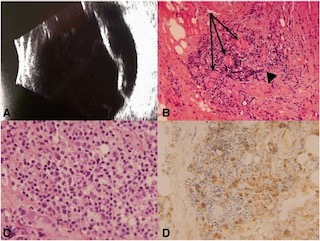IgG4-associated orbital and ocular inflammation is a relatively newly discovered disease which can manifest in the eye as sclerosing inflammation with infiltration of IgG4-positive plasma cells. This disease tends to affect tends to affect people in the middle-aged to elderly years, and the most commonly involved sites are the pancreas, the salivary and lacrimal glands, and the orbit. Some so-called idiopathic inflammation syndromes are being re-classified as IgG4-associated inflammation based on results from histopathologic evaluation. In this study, Dr. Lee and her coauthors report three cases of IgG4-associated ocular and orbital inflammation, each with a different presentation/manifestation: sclero-uveitis, pachymeningitis with associated bilateral optic neuropathy/perineuritis, and inflammatory pseudotumor of the orbit.
IgG4-associated disease was first described as a systemic condition in 2003 when extra-pancreatic manifestations were identified in patients with autoimmune pancreatitis, a condition known to be associated with elevated levels of IgG4. Since that discovery, the presence of IgG4-related inflammation has been detected in virtually all organs, particularly the pancreas, liver, kidney, lung, and thyroid. In ophthalmology, IgG4-associated disease most frequently presents with involvement of the orbit/lacrimal gland.

The three interesting cases described in this study confirm that histologic analysis of biopsy specimens is critical in diagnosing IgG4-related disease. Ophthalmologists should keep IgG4-associated inflammation in mind when examining chronic, sclerofibrosing inflammation with multi-system involvement. The authors discuss the different treatment approaches for each of these three patients, as well as provide a review research on other associated conditions with similar, potentially related pathology. They note that timely assessment of this condition may lead to fewer diagnostic tests and more targeted therapy.
Lee CS, Harocopos GJ, Kraus CL, Lee AY, Van Stavern GP, Couch SM, Rao PK. IgG4-associated orbital and ocular inflammation. J Ophthalmic Inflamm Infect. 2015;5:15. doi: 10.1186/s12348-015-0047-y. eCollection 2015. PubMed PMID: 26034515; PubMed Central PMCID: PMC4446498.

